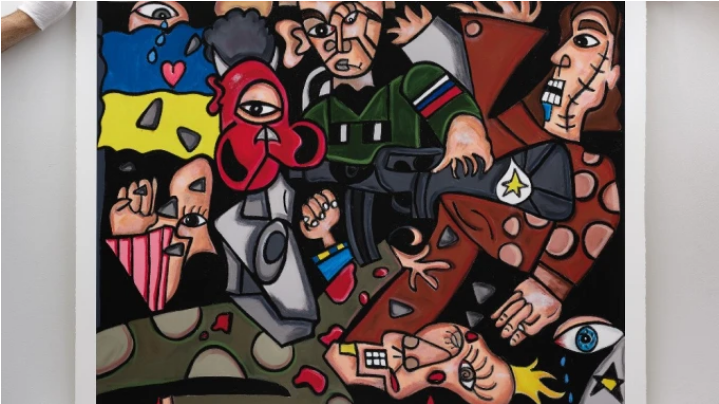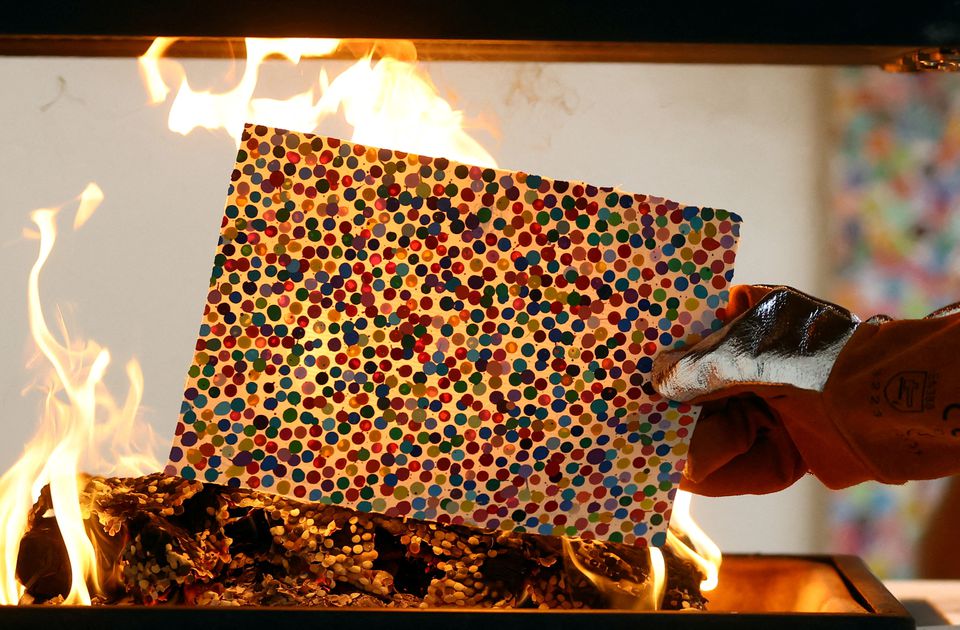1. “Take the Money and Run”

The Kunsten Museum of Modern Art Aalborg held an exhibition that was on view from the mid of September 2021 until the beginning of 2022. Immediately before the exhibition opened, Jens Haaning, a Danish artist sent two blank canvases to the Museum. He was commissioned to reproduce two of his previous works representing the annual salary in Denmark and Austria made of banknotes worth $84,000. However, instead of recreating the artwork, the artist sent blank canvases entitled “Take the Money and Run”.
According to the Kunsten Museum website, until the exhibition was over, Jens Haaning did not return the money.
The artwork has spawned a debate about whether this work is art or fraud. Haaning’s case seems to be a part of his conceptual art, in which the artist intentionally “take the money and run” to make people think about the issue of workers’ right and working condition, both in the art world and in larger structure society.
2. Portraits of Ukraine

In early 2022, the world was shocked and saddened by the Russian invasion of Ukraine. The war disrupts Ukrainian lives and routines, including in the art world. Nevertheless, some Ukrainian contemporary artists continue to create their artworks. They were inspired by the modern daily life of the Ukrainian, folklore, historical legacy, natural beauty, as well as social and political issues. Some of the artists also depict “the spirit of their country and the war’s toll.”
The invasion of Ukraine also draws the attention of abroad artists. One of them is Andres Valencia, a contemporary young artist, based in San Diego, California. The artist captures the Ukrainian war in the Invasion of Ukraine (2022) which he wants to be known as today’s Guernica.
3. Burning Artwork for the NFTs

Damien Hirst, a British artist, in his project entitled “The Currency” burned 1,000 pieces of his artworks worth millions of US dollars for selling them as NFTs. The buyers should opt to keep the NFT or the physical artwork.
The artist considers the artwork burning not as a destruction of millions of dollars of art, but it is a process to complete the transformation of physical artworks into NFTs.
Interest in NFT art had experienced a decline but rise again because the collectors realize the strong commercial value given by the NFT works.
The burning of artworks to sell them as NFTs is still debatable whether it is an “art expression” or merely a “commercial object” to trade.
It is not surprising that artwork burning will be a trend in the future. However, people need to be aware that NFT arts could be a ‘bubble’ that someday will ‘burst’ when the NFT boom is over.
4. Climate Activists’ Attacks to Art Masterpieces
https://juststopoil.org/2022/07/04/young-supporters-of-just-stop-oil-glue-themselves-to-a-constable-at-the-national-gallery/
Anti-fossil-fuel activists across countries targeted world-famous art masterpieces in many museums. The activists demanded the government stop oil exploration.
They glued themselves on some paintings, including a copy of Leonardo da Vinci’s The Last Supper at the Royal Academy of Art in London, van Gogh’s Peach Trees in Blossom (1889) at London’s Courtauld Gallery, and a J. M. W. Turner’s Thomson’s Aeolian Harp (1809) at Manchester Art Gallery.
During October, at least three famous artworks were attacked by Eco-Activist. Mashed potato on Monet’s Haystacks, a can of tomato soup on Vincent van Gogh’s Vase with Fifteen Sunflowers, and glue on Johannes Vermeer’s Girl With a Pearl Earring.
Fortunately, none of these artworks are damaged because they are protected by glass.
Questions need to think regarding this movement are: Is attacking art masterpieces effective to warn the government to stop the new oil exploration? When the authority will listen to their demand? What can art do to stop climate change?
5. AI-Generated Artworks
During 2022, the art world has been challenged by the emergence of Artificial Intelligence (AI) arts. An art piece created using a text-to-image generator won the first winner in an art competition. Jason M Allen submitted his work produced using Midjourney to the Colorado State Fair art competition under the category of Digital Arts/ Digitally-Manipulated Photography. This work spawned debates about whether AI art can be considered original work, can AI art be submitted to a competition, and whether can AI replaces the artist’s role.
AI-generated images called Lensa, also sparking controversy about whether this AI image generator is stealing from human art or not. The Lensa creates stunning profile portraits in some artistic styles. Lensa’s images are alleged to take some artists’ original characteristics without consent.
AI arts can open a huge opportunity for artists to make creative works and be more productive. However, a thing that should be a concern in the future is ethics issues regarding AI-generated arts.
